|
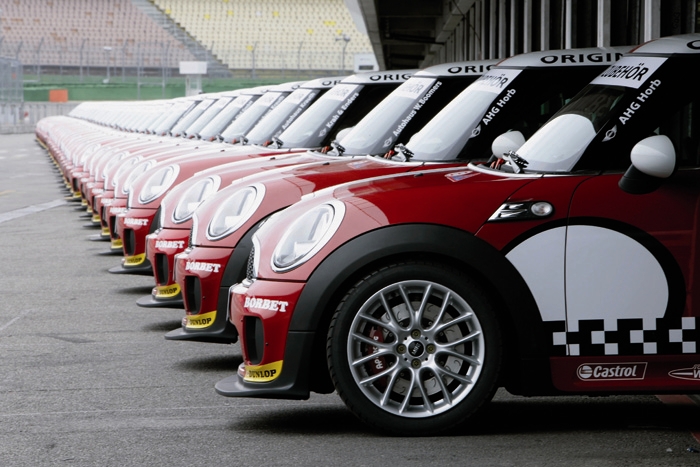
3. From the Racing Track Straight to the Road.
John Cooper Works and the MINI Success Story in Motorsport.
It is in the car's DNA and it was obviously there right from the start: the sporting talent of the classic Mini.
When Alec Issigonis was requested by British Motor Corporation (BMC) in late 1956 to develop an economical
but nevertheless fully-fledged small car with four seats, it quickly became clear that this new model would be truly innovative and, indeed, revolutionary in every respect.
Front-wheel drive, extremely short body overhangs, a wide track, a low centre of gravity, optimum use of space and low weight were defined right from the start as elementary features of the new model.
Looking at the first drawings of the new car by his business partner and friend Alec Issigonis, sports car wizard John Cooper noticed yet another significant quality right from the beginning: He recognised that this
ingenious concept for an economical compact car also provided the ideal starting point for a most promising sports model, setting out on the process of tuning the Mini even before the car had entered the market.
This set the starting point for an unprecedented story of success in motorsport, closely connecting the name John Cooper with the sporting myth of the MINI to this very day. Outstanding victories in the Monte Carlo
Rally are just as much part of this common history as the successful production cars proudly bearing the name Cooper.
Now integrated within the MINI organisation, John Cooper Works represents the epitome of supreme driving pleasure based on both well-founded know-how in motorsport and successful cooperation going back years and even decades.
Apart from accessories for the drivetrain, suspension, streamlining, and design, three special versions of the MINI now also bear the brand logo so symbolic of outstanding performance: the MINI John Cooper Works, the
MINI John Cooper Works Clubman, and the MINI John Cooper Works Convertible.
Racing pioneer John Cooper teaches Mini how to win.
Born in Surrey in 1923, John Cooper was one of the most outstanding celebrities in international motorsport – both as a driver and, even more so, as a constructor.
Together with his father he established the Cooper Car Company in 1946, the two enthusiasts starting out with the construction of racing cars first for Formula 3, later also for Formula 1. Through their concept of a
mid-engined sports car Charles and John Cooper set a truly revolutionary trend in the entire world of motorsport in 1955, Cooper racing cars winning both the Constructor's and Driver's titles in the World Formula
1 Championship in 1959 and 1960, for the first time in the history of motorsport with the engine mounted in the middle. And with this concept proving its success so convincingly, it is no surprise that soon all cars in
Formula 1 came with a mid-mounted engine.
John Cooper and Alec Issigonis became close friends in the course of time after meeting and competing
against one another at numerous races. There were also professional ties between the two enthusiasts, with the Cooper Car Company buying engines from BMC.
When it came to the Mini, however, the sporting ambitions of the two constructors were very different: Issigonis was looking above all at the right car for everyday motoring, Cooper was thrilled by the sporting
potential of this small and nimble performer. So back in 1959, the very first year of the Mini, he sent his driver Roy Salvadori to Monza in the very first Mini Cooper, a special one-off model built specifically for this
purpose. And indeed, this new sports car immediately proved its qualities on the way to Monza, Salvadori covering the distance more than an hour faster than his colleague Reg Parnell – who just happened to be
driving an Aston Martin DB4.
Motivated by initial success in the 1960 Monte Carlo Rally, Cooper suggested building a GT model based on
the Mini. And despite Issigonis' rather sceptical opinion at least to begin with, George Harriman, the Chief Executive Officer of BMC, ultimately decided to build a small series of 1,000 Mini Coopers featuring a 55-hp
power unit, that is 21 extra horsepower made possible by far-reaching modifications of the engine.
The Mini Cooper's top speed was approximately 130 km/h or 80 mph. The car's transmission ratios were
adjusted to the sporting potential of the engine and disc brakes on the front wheels ensured adequate stopping power.
Soon Issigonis was also thrilled by the results of these efforts. So joining forces with John Cooper, he quickly started working on the next engine upgrade, increasing engine bore to the ultimate limit on the Mini Cooper
S: At 1,071 cc, engine capacity remained below the mark of 1,100 cc applicable in the particular class of motorsport seen as the target, with the engine revving up to impressive speeds. Maximum output was 70 hp
at 6,200 rpm, maximum engine speed was 7,200 rpm.
This version was again equipped with new brakes, braking power being boosted by a brake servo.
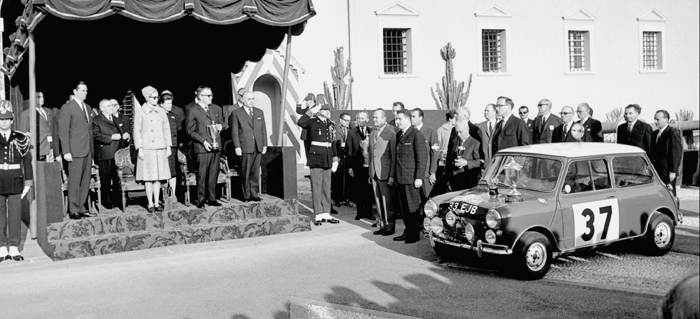
Princely reception: Hopkirk/Liddon taking the winner trophy, Rallye Monte Carlo 1964

Calender sheet February: Paddy Hopkirk won the 1964 Monte Carlo Rally
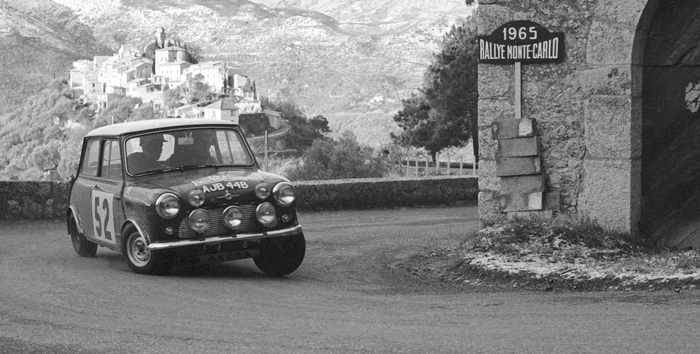
Mäkinen/Easter in the Mini-Cooper at the Monte Carlo Rally, 1965
1964–1967: the golden years in the Monte Carlo Rally.
This set the basis for sensational success in motorsport, the Mini Cooper S hitting the headlines in Monte
Carlo for the first time in 1962. With Finnish driver Rauno Aaltonen at the wheel, this small but highly nimble performer successfully left behind a whole pack of far more powerful Goliaths. But just three kilometres away
from home, Aaltonen, leading the race at the time, misjudged a bend and finished the Rally with a rollover.
Only a year later, however, Aaltonen made up for this misfortune, bringing home class victory in the Mini
Cooper S and finishing third overall.
But even more – and even better – was still to come: Entering the 1963/1964 rally winter, the Mini Cooper S
was simply oozing power in comparison with its predecessor. So in a spectacular race, Paddy Hopkirk brought home first place overall in the Monte Carlo Rally, the small performer becoming a legend in motorsport
virtually overnight.
A year later Finnish racer Timo Mäkinen with his co-pilot Paul Easter repeated the same triumphant victory,
reaching the finish line after thousands of kilometres as the only driver without one single penalty point – despite the worst weather imaginable. Indeed, only 35 out of 237 cars entered in the event were able to
finish the Rally that year, among them no less than three Mini Cooper S.
The following year was the year of the hattrick, Timo Mäkinen, Rauno Aaltonen and Paddy Hopkirk scoring an
absolutely incredible victory, finishing first, second, and third. But this was followed by bitter disappointment, the first three cars being disqualified because the rally commissioners came to the conclusion that the low
beams on the Mini's main headlights failed to comply in full with the homologation rules.
Even so, the public were completely thrilled by the three Mini drivers, despite this questionable decision,
Hopkirk, Aaltonen and Mäkinen therefore entering the annals of the Monte Carlo Rally as the "Three Musketeers". And indeed, just one year later Rauno Aaltonen received truly overwhelming applause and
acknowledgement when bringing home the third overall victory of the Mini Cooper S in the Monte Carlo Rally. Especially because this time there were no complaints about his car.
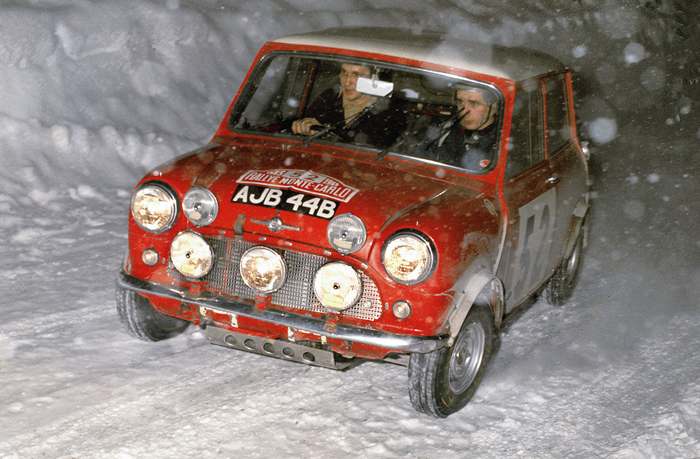
Repeater: Mini Cooper S winning the Rallye Monte Carlo the second time –? in 1965 with cockpit Mäkinen/Easter
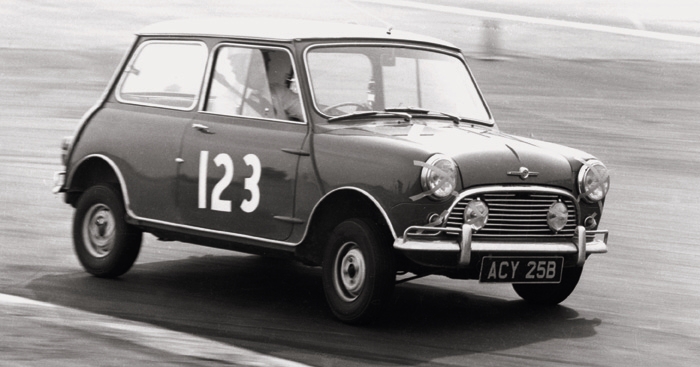
Mini Cooper in a race, 1965
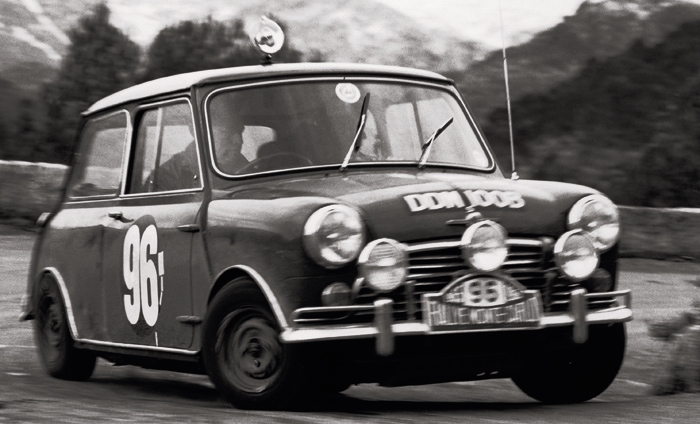
Mini Cooper at the Monte Carlo Rallye, 1965

Mini Cooper in a race at Oulton Park, 1965
Legendary racing careers started at the wheel of a Mini.
The Mini was however highly successful not only in rally racing, but also on road circuits, bringing home
numerous wins in the 1960s. Indeed, through its long list of successes in motorsport, the Mini became the most outstanding racing car of the entire decade.
A particularly interesting point is that many spectacular racing careers started at the wheel of a Mini, a certain racing driver from Austria called Nikolaus Andreas Lauda entering his first hill-climb race at the wheel
of a classic Mini near the Austrian town of Linz in April 1968, and immediately finishing second. Only two weeks later Lauda again confirmed his talent when scoring his first racing victory in a career which would
take him on to three Formula 1 World Championships. And just like Niki Lauda, Formula 1 Champions Graham Hill, Jackie Stewart, John Surtees, Jochen Rindt, and James Hunt all gained their first racing experience in a
classic Mini.
Just like the car's sporting career, sales of the Mini Cooper with its special configuration developed by John
Cooper Showed an exceptional story of success from 1961–1971, the name "Cooper" becoming a synonym worldwide for passionate driving pleasure in the Mini.
The fact that this tiny car had inspired the two-time Formula 1 World Champion to build outstanding sports cars was sufficient proof of the Mini and its qualities. And indeed, the unique driving experience inducing John
Cooper right from the start to continue the development of the Mini all the way to perfection was equally thrilling back then for every fan of sporting automobiles.
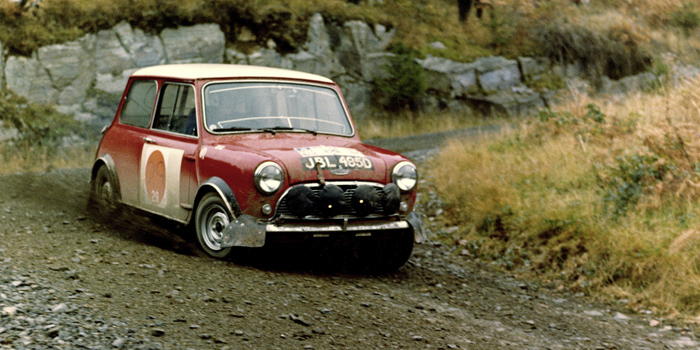
Mini Cooper S at the R.A.C. Rally 1966
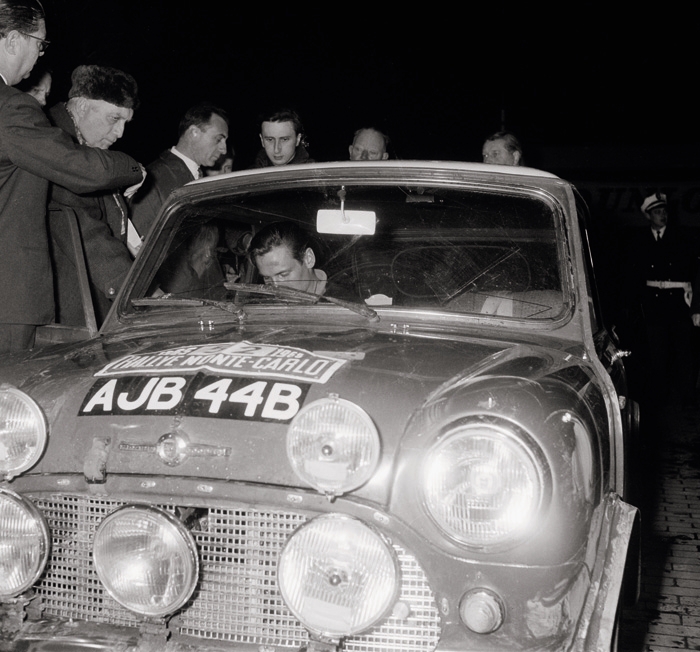
Timo Mäkinen and Paul Easter in the Mini Cooper at the Monte Carlo Rallye, 1965
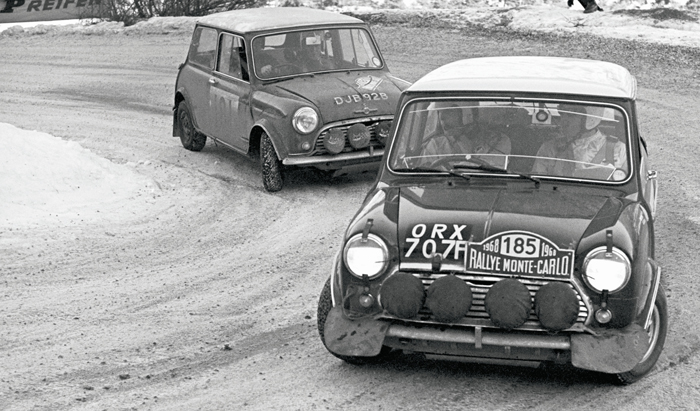
Fall/Wood on Mini Cooper S, Rallye Monte Carlo 1968 (finishing 4th place)
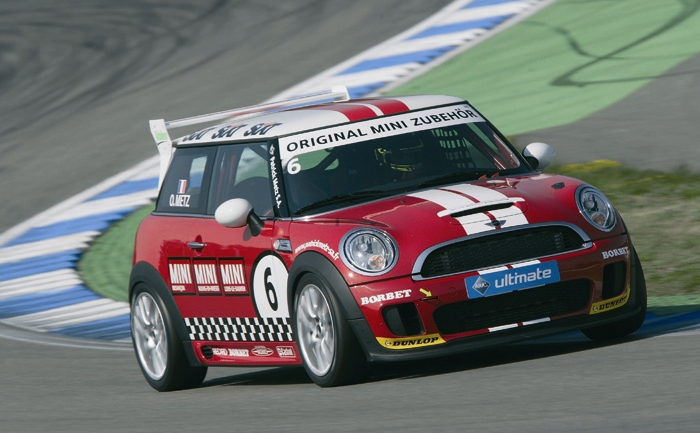
Motorsport meets lifestyle: the MINI CHALLENGE.
In the meantime MINI has become a regular sight on the race track, the MINI CHALLENGE held for the first
time in 2004 becoming one of the most successful and popular clubsport series in the world.
This year the series will be held in four countries (Spain, Australia, New Zealand, and Germany), making it
more international than ever before.
Boasting a line-up of no less than 39 registered cars, the German MINI CHALLENGE 2009 already shows
record participation, just as the number of races for the Championship is greater than ever before, with no less than 16 races on eight racing weekends.
As usual, these races will be held on the occasion of most outstanding motorsport events in Germany and neighbouring countries. As an example, the MINI CHALLENGE 2009 will be making a strong appearance on the
occasion of Formula 1 events (GP of Germany, Nürburgring) and in the WTCC World Touring Car Championship (Oschersleben).
A very special highlight of the season will be taking place in Great Britain, the German MINI CHALLENGE 2009 moving to the home country of the MINI brand exactly in time for MINI's 50th birthday, where the race will
be the sporting highlight of the MINI United Festival on the legendary Silverstone Circuit.
The MINI CHALLENGE owes its exceptional popularity to a truly innovative concept: motorsport meets
lifestyle – a mixture very appealing to both drivers and fans alike.
The list of drivers also contributes to the popularity of the event, with old hands and rookies from motorsport
taking on celebrities from show business and many other disciplines of sport.
The sporting symbol of the MINI CHALLENGE is equal chances, with all drivers entering the races in cars
identical in technical terms. Through the superior handling of the MINI and the high standard of safety equipment in the racing models, the MINI CHALLENGE is of particular interest to racing beginners and
ambitious amateur drivers.
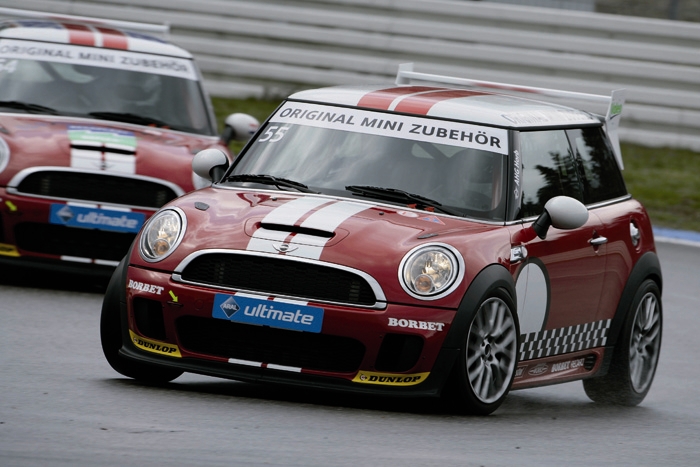
Ready to race: the MINI John Cooper Works CHALLENGE.
The official, one and only racing car entered in the MINI CHALLENGE is the MINI John Cooper Works
CHALLENGE based on the series version of the MINI Cooper S and set up by MINI's racing engineers for the outstanding demands of professional motorsport.
Having been raced since 2008, the MINI John Cooper Works CHALLENGE has already thrilled drivers everywhere. For apart from the "go-kart feeling" so typical of the MINI, the car offers a most intense driving
experience at the high level of genuine motorsport. And as a further asset, not only drivers participating in the MINI CHALLENGE are able to enjoy this outstanding racing car, but also other, ambitious motorsport
enthusiasts who naturally have the option to buy the MINI John Cooper Works CHALLENGE too.
Special power treatment makes the already very dynamic and muscular regular engine of the MINI Cooper S a
genuine high-performance athlete ready for racing in the MINI John Cooper Works CHALLENGE. The power unit within the engine compartment is a 1.6-litre four-cylinder equipped with a twin-scroll turbocharger and
direct gasoline injection. Maximum output is 155 kW/211 hp at an engine speed of 6,000 rpm.
To provide this kind of ideal racing performance, the characteristics of the engine have been additionally
optimised, with maximum torque of 260 Newton-metres or 192 lb-ft maintained consistently between 1,850 and 5,700 rpm. Overboost increases this muscle even further to 280 Newton-metres or 206 lb-ft in the range
from 2,000–5,000 rpm. And since the turbocharger develops its superior effect at just 1,400 rpm, the driver need not fear that usual turbo "gap".
Top-flight performance.
Every horsepower in the MINI John Cooper Works CHALLENGE has to cope with a power-to-weight ratio of only 5.09 kg or 11.2 lb – a figure which places the MINI John Cooper Works CHALLENGE close to the most
thoroughbred and dynamic sports cars. Performance on the road is correspondingly impressive, the MINI John Cooper Works CHALLENGE accelerating from a standstill to 100 km/h in just 6.1 seconds. By contrast, the car
takes just 3.1 seconds or 31 metres (102 ft) to return to a standstill from this kind of speed.
Top speed, finally, is 240 km/h or 149 mph.
Yet a further forte is the very high speed the car is able to reach in bends, the limited-slip differential making it much easier for the driver to remain on the ideal line also when coming out of a bend at high speeds, to
accelerate without the slightest interruption, and therefore to "swing round" all of that speed in accelerating on to the next straight.
The MINI John Cooper Works CHALLENGE gives the driver the assurance even under extremely demanding conditions that he is driving safely and smoothly on the track at all times. This is made possible by the
suspension equipped with adjustable shock absorbers specially conceived for motorsport.
With these shocks, ground clearance, damper pressure (inbound and rebound) and suspension response may
be adjusted to the demands and requirements of various race tracks, power being fed to the front wheels through the usual six-speed manual gearbox.
The MINI John Cooper Works CHALLENGE comes on 17-inch lightweight rims in MINI CHALLENGE design and with specially developed racing tyres. Minimum starter weight (car and driver) is 1,170 kg or 2,580 lb.
One of the important factors contributing to the superior handling of the MINI John Cooper Works CHALLENGE is the John Cooper Works Aerodynamics Package comprising a special racing-type front spoiler, a rear
diffuser, and an adjustable rear wing. Combined with one another, these components not only eliminate lift forces, but even generate growing downforce as the car becomes faster. These aerodynamic improvements
are indeed conceived in such a way that downforce between the front and rear axle is perfectly balanced.

Unique safety concept – typical of the MINI CHALLENGE.
Combining motorsport and safety has always been one of the primary commitments in the MINI CHALLENGE.
This explains why the standard of safety offered in the events is particularly high, the racing cars featuring a safety cage welded firmly to the body.
Over and above the sports bucket seat combined with a six-point seat belt, standard equipment also includes the HANS (Head And Neck Support) system well-known in Formula 1 and now carried over for the
first time to a clubsport car, with its highly effective protection of the driver's neck area. Another example is the ABS anti-lock brake system remaining fully functional through its set-up perfectly adapted to racing
requirements.
The MINI John Cooper Works CHALLENGE also guarantees fast action and superior safety in pitstops, for example in qualifying. Each racing car comes with its own integrated hoist mechanism made up of four
pneumatic stands moving out of the bottom of the vehicle under compressed air to lift up the entire car instantaneously. Clearly, this enables the driver and his team to change tyres virtually within a matter of seconds.
John Cooper Works – the epitome for extreme driving pleasure in the MINI.
John Cooper Works guarantee outstanding performance not only on the race track, but also on the road.
Even back in the 1970s, John Cooper Works Tuning Kits for production versions of the Mini were very popular and even back then the classic Mini equipped with such special features and components was able to show
its most outstanding virtues both visually and in technical terms.
The same applies to the tuning kits for the MINI Cooper S and the MINI Cooper Successfully introduced after
the re-launch of the brand and available in the market under the label of John Cooper Works. The current tuning kit for the MINI Cooper S is made up of a sports air filter, a sports silencer and modified engine
electronic management, even minor expenditure serving to increase power to 141 kW/192 hp and give the car particular signs of distinction in both its looks and sound.
Clearly, the three extremely sporting versions of the MINI live out all the performance-oriented character of the brand. Following the MINI John Cooper Works and the MINI John Cooper Works Clubman, the MINI John
Cooper Works Convertible will also be entering the market in this anniversary year.
The most important feature shared by these three outstanding models is their drivetrain and suspension
technology carried over from the racing version of the MINI CHALLENGE. Over and above the 155 kW/211 hp power unit, this gives the three road-going models a wide range of other components serving to convey the
supreme power of the engine smoothly, safely and with full agility to the road.
Apart from the 17-inch light-alloy rims likewise derived from the racing version in the MINI CHALLENGE as well
as appropriately large and powerful disc brakes on all four wheels, DSC Dynamic Stability Control including DTC Dynamic Traction Control and an electronically controlled locking function on the front axle differential all
come as standard.
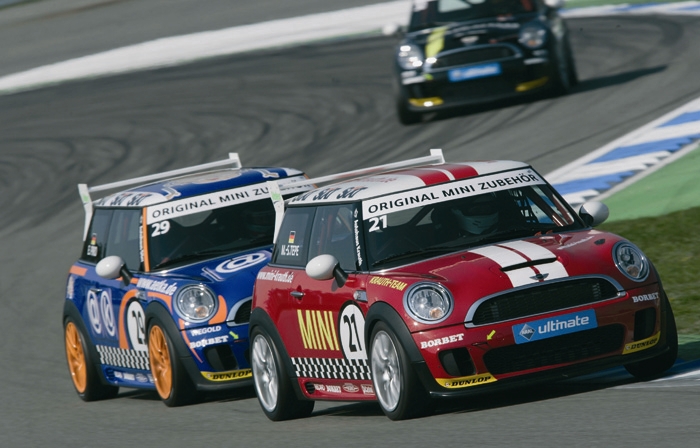
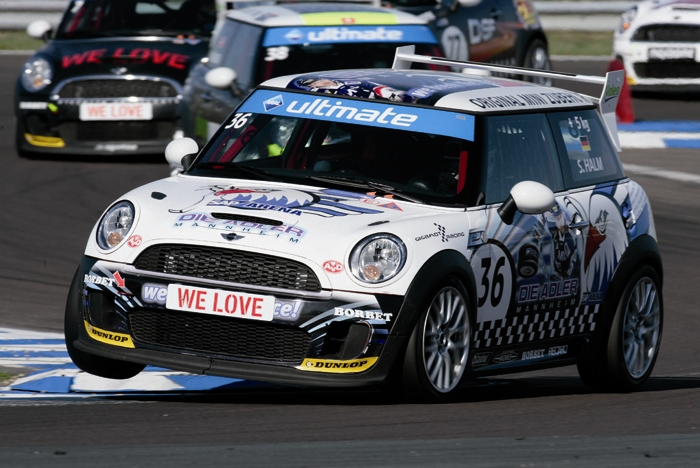
|


